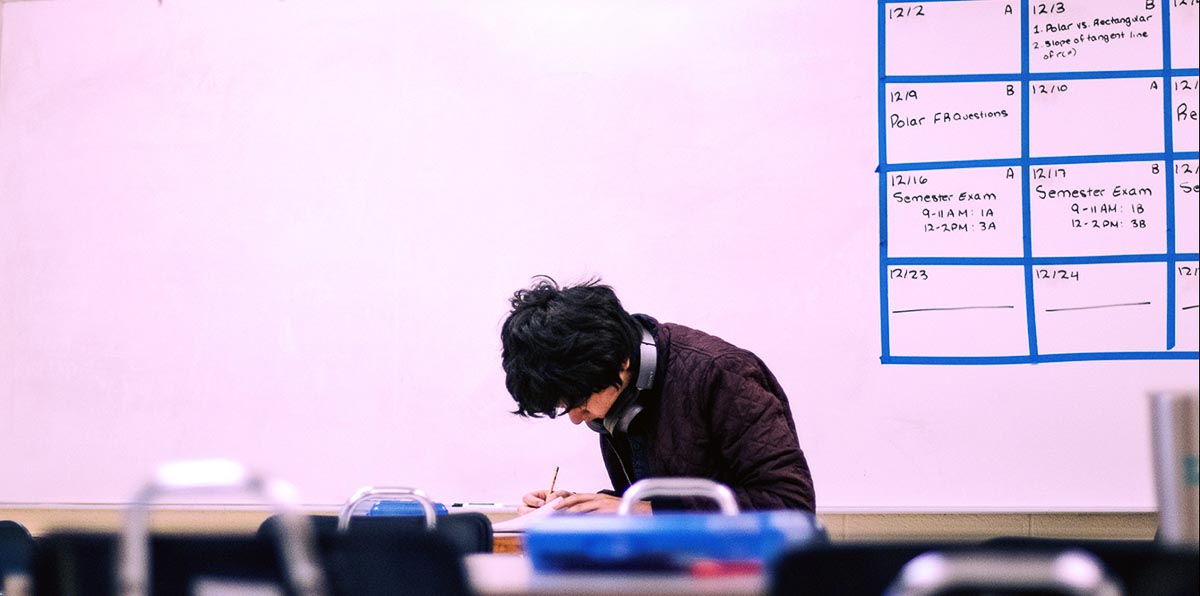At a time when Americans seem to be divided on almost every issue, there are at least two things that spark no debate: the best path to opportunity is a college education — and — a college education is expensive.
COVID-19 has impacted and complicated every aspect of American life, including creating new obstacles to higher education for many. With all of the health and safety concerns — and uncertainty — about the disease, and the economic repercussions of the pandemic, it’s no surprise that undergraduate enrollment is down 4% this year compared to 2019. That’s according to new data from the National Student Clearinghouse Research Center.
But outbreak aside, college remains expensive. On average, the annual cost for undergraduates at a public university in the U.S. is $20,000 (tuition, fees, room and board). That jumps to $46,000 for private nonprofit universities. And the costs continue to rise.
For many, paying for college just isn’t possible without financial aid. Some 85% of first-time, full-time college undergrads depend on some amount of financial aid, according to the National Center for Education Statistics.
No financial aid without the FAFSA
Before students can access federal financial aid — grants, scholarships, loans, money for work-study programs — they have to complete the FAFSA: Free Application for Federal Student Aid. In short, the FAFSA is used to determine how much financial aid a student qualifies for, based on financial information from the previous year’s tax returns. Eligibility can range from grants and scholarships, which don’t have to be paid back, to student loans (like a low-interest-rate Stafford Loan) that must be repaid.
Each year, FAFSA provides almost $150 billion in financial assistance to more than 13 million students. But each year, many students miss their chance at a lot of money they’re eligible to receive because they don’t turn in the form. For instance, according to Nerdwallet, $2.6 billion in Pell Grants went unused in the 2018-2019 academic year because of unsubmitted FAFSAs.
A common misperception among students and their families is that their household incomes are too high to qualify for student aid. In truth, most students qualify for some form of aid, but only if they complete the FAFSA.
Correlation between FAFSA completion and college
FAFSA completion — which includes submitting it — is a strong early indicator of enrolling in college. According to the Nation College Attainment Network (NCAN), high school seniors who complete the FAFSA are 84% more likely to immediately enroll in postsecondary education.
And among students from the lowest socioeconomic level, those who complete the FAFSA are 127% more likely to be enrolled in a postsecondary program the fall after graduating from high school than those who don’t.
The window for completing the FAFSA opened Oct. 1, and students have until June 30 to submit the form; however, experts recommend filing as early as possible to get the best shot at aid.
Though it’s still early in FAFSA season, year-to-year comparisons of completion rates are lagging at all levels, according to NCAN’s FAFSA Tracker. Through Oct. 9, 6.4% of high school seniors (242,358) in the U.S. had completed the FAFSA. That’s 14.3% lower than the same period last year. In Texas, 8.3% of seniors (29,723) have completed their FAFSA, which is down 13.6% from last year at this time.
Locally, completion rates vary from district to district. In the Sheldon, Alief, Pearland, Fort Bend, Spring Branch and Montgomery independent school districts, FAFSA completion rates are up this year compared to 2019. But current completion rates are down between 10 and 17% in other school districts in the Houston area, including Katy, Friendswood, Alvin and Cypress-Fairbanks. It’s 6.1% lower among seniors in Houston ISD and has dropped almost 36% in Aldine ISD.
Disparities in the declining rates
The data also show disparities along racial and socioeconomic lines. In Texas, the FAFSA completion rate for seniors in Title 1 high schools is 18.6% lower than it was at the same time last year. Compare that to high schools that are Title 1 ineligible, where rates are down, but only 5.4%. High schools in which 40% or more of the students are Black and Hispanic have seen a 17.3% decline, compared to a drop of 11.2% in predominantly white high schools.
Students also have to renew their FAFSA each year. According to an analysis of federal data by NCAN, renewals are down 1% overall this year. They’re even lower for low-income students — down 5.4% among those whose families earn less than $25,000 a year. Many of these students are eligible for need-based assistance.
Starting in the fall of 2021, high school seniors in Texas will have to complete the FAFSA to graduate. The state will be one of three — along with Louisiana and Illinois — to make it a requirement. It’s a step that is sure to improve completion rates but, even under normal circumstances, it’ll require a lot of work on the part of high schools and school districts. Currently, circumstances aren’t normal, and even the most optimistic projections don’t have “normalcy” returning by next fall.
Students and families need clear information about the application as well as simple, straightforward instruction and assistance in completing it. There are a lot of good resources available to help students and families navigate the process of filling out and filing the FAFSA, and this recent story from NPR does a good job of explaining what it all means and aggregating much of it into one place.
So, it’s important to understand the benefits of filing the FAFSA as well as the need for a 100% completion rate among high school seniors. If not, it’ll only add to the growing list of gaps that are widening because of the pandemic. These days, there are more than enough things students and their families have to worry about without also having to choose between racking up huge debt while pursuing education and training beyond high school and foregoing the opportunity of education.

